After a year in the water Pitufa was in desperate need of a new antifouling, the Hempel Alusafe we had put on in Croatia just wasn’t up to the critters that populate Caribbean waters (even though we had scraped off barnacles and algae weekly). Additionally we wanted to check why our steering was getting stiffer and stiffer. On the Atlantic crossing it had started squeaking so alarmingly that we didn’t dare going much further without checking it. We compared boatyard prices in Grenada, the ABC islands and Columbia and decided on hauling out at Grenada Marine in St. David’s Harbour in the Southeast corner of Grenada. They don’t only offer a reasonable price, but also allow yachties to work in the yard themselves. Picking Grenada marine turned out to be a wise decision, because when we had Pitufa on the hard we discovered more and more jobs that had to be done and they have a huge staff of workmen who dealt expertly with all our problems.
We hauled out Pitufa on April 17, 2012, and immediately started working on our two main projects: rudder and antifouling. In order to take off the rudder Christian first had to unmount the skeg–not so easy with bolts hidden in a thick layer of filler.
After digging out the bolts with the angle grinder, taking off the skegg was quite simple, but the rudder shaft was so stuck in the bearings that heavy measures were required. After half a day of hammering, wiggling and shoving it finally came off and revealed what had been the problem: an elaborate, double, self-aligning roller bearing. The head of the mechanics department quickly came up with a simpler and sturdier solution: delrin bushings. However, removing the old bearings required an extra amount of brutality…
One of the mechanics noticed that the rubber sleeve bearing of the propeller shaft had too much play, so we decided to replace it as well.
While Christian was busy with the rudder I was sanding Pitufa’s hull with an orbital sander, removing residues of barnacles and loose antifouling. It’s hard to find an effective antifouling for an aluminium boat and in the end we decided on Seahawk Biotin Plus and hope that it’ll last a few years. At the end we put on 7 gallons (= 26.5 litres) of antifouling paint! As antifouling is quite poisonous I upgraded my outfit constantly.
We made some smaller repairs and paint jobs.
One of the terminals of our upper shrouds had a crack so we decided to have them both replaced. We used the opportunity of having experts in all fields of boat repair around to have the rigger check our standing rigging. The new shrouds arrived the next day (Friday), we thought we had everything settled and were eager to get into the water right after the weekend. But when climbing down from the mast the rigger brought devastating news: he had discovered a vertical crack in the mast, about 30 cm long and almost at the top. Sailing like this was out of question. We had to postpone the launching date and have the mast pulled instead on Monday. Spending the weekend like this was quite nerve wrecking: Would they be able to repair the crack?
On Monday the crane arrived first thing in the morning. We were worried, but the rigging team had it down in a jiffy and for a change we got good news: the aluminium around the crack looked sound and the welder would be able to repair it.
Having the mast down was also a good opportunity for us to sand off the loose paint (we had meant to do that for ages) and to mount the mast steps that we had carried around in the forecabin since setting off in Croatia. We decided against painting it anew, because that would have meant undoing all fittings (most of them corroded solid) and painting an aluminium mast is more of an asthaetic thing anyway. So we’ll leave it bare, it’ll grow greyish and stained after a while, but that’s o.k. for us. It still took us almost a week of hard work in the blazing sun (over 30 degrees, humidity usually around 97 %) to finish the mast. Additionally we had the forestay and the inner forestay changed, because we were not sure how old the rig was and wanted to have them replaced before venturing out into the Pacific anyway, so this seemed a good chance.
After three weeks instead of the expected ten days Pitufa was ready to get back into the water, now in a blue and smurfier outfit, her crew exhausted but happy and ready to sail again towards the horizon!


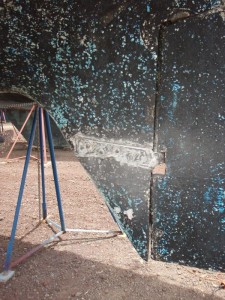
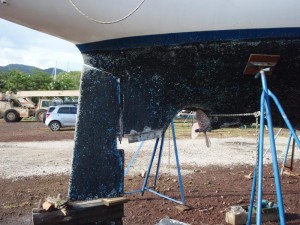
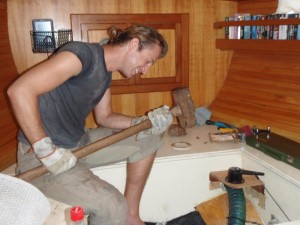
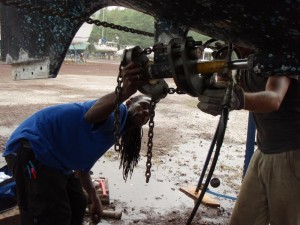
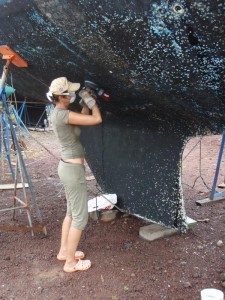
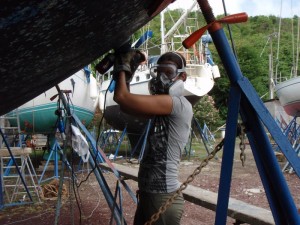
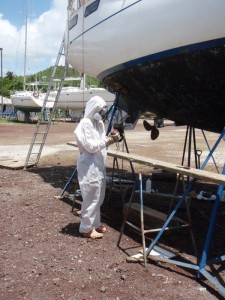
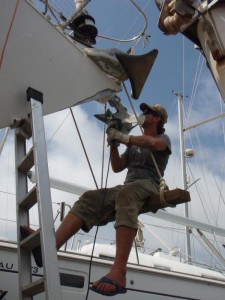
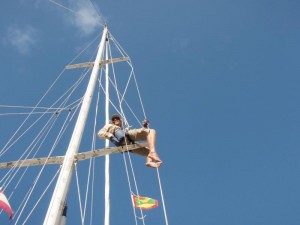
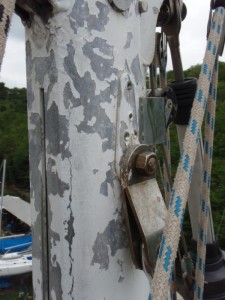
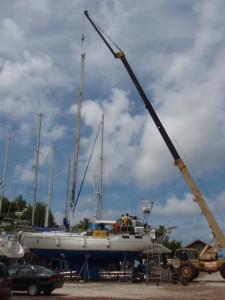
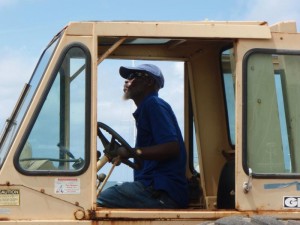
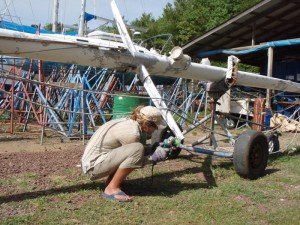
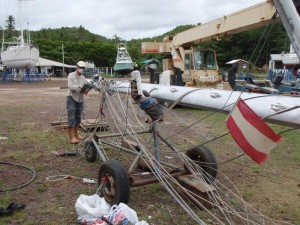
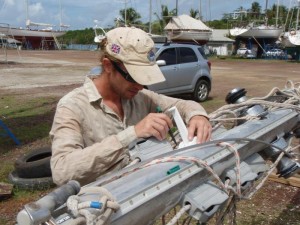
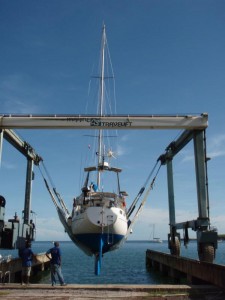





3 comments
Roswitha Feldbauer says:
May 14, 2012 at 11:39 am (UTC 0)
OMG! Das sieht echt nach Arbeit aus. Zum Glück seid´s fertig.
Chris says:
November 12, 2013 at 11:19 am (UTC 0)
Hi How is the antifouling holding up so far ,I have been using Trilux33 and need a change and hope to do seahawk biotin if I can get it shipped to marshall islands
Christian says:
November 12, 2013 at 4:59 pm (UTC 0)
Hi Chris,
That’s funny you ask that, as we are considering switching to a hard antifouling such as trilux33. So we guess you are not very happy with trilux33. how strong was/is the growth on it?
biotin was not bad, at least in the first couple of months in the caribbean where we had absolutely no growth. then we sailed to Cartagena, Colombia, and got such an incredible barnacle growth in their polluted water that our almost new af got killed (when scraping off those big barnacles also the af comes completely off with them). later, around panama and in the pacific (galapagos, gambier islands, marquesas), barnacles were not an issue, only algae grew, but those can be wiped away easily.
but exactly that wiping and scraping is the main problem with a soft af as so much paint comes off every time. we think now, since frequent cleaning is inevitable anyway, that a hard af would be better in this respect. what do you think, what’s your experience?